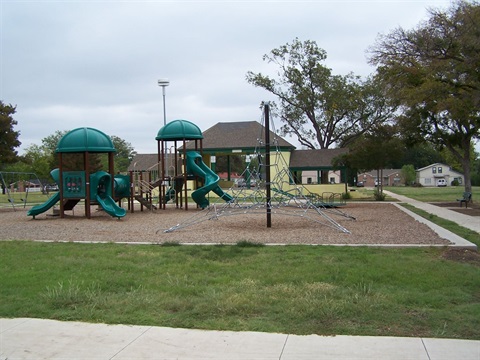Rosemont Community Park

Dedication
Size
Additional amenities
- Backstop
- Basketball court
- Bench
- Bleachers
- Fountain
- Electrical box
- Fitness station
- Grill
- Park lighting
- Parking lot
- Playground area
- Restroom
- Shelter
- Soccer field
- Softball/baseball field
- Special use facility
- Stand-alone swing
- Table
- Trash receptacle
- Volleyball court
Fun facts
Rosemont Park is 30 acres filled with a variety of recreational opportunities. Walking all the cement trails at the park equals nearly two miles.
History
Rosemont Park in south Fort Worth was acquired by the City in 1927 when it purchased 68 acres from C. L. Mobley for $37,400. The tract had been owned by Rosa Steele for 54 years. Miss Steele created a trust fund with the proceeds of the sale going to various charities. It is believed that the park received its name in recognition of Miss Steele.
In 1936-37, the park received a new shelter and sidewalks as a result of funding through the WPA. During World War II, a portion of the park was dedicated to temporary housing. Barracks-style apartments were constructed by the federal government for defense workers. Following the war, the housing was turned over to City’s housing authority. In 1953, nearby residents complained that the buildings were a blight on the surrounding neighborhood and the City Council ordered the city manager to conduct an inquiry into their removal.
In September 1954, the park board approved the sale of 28 acres on the west side of the park to Southwestern Baptist Theological Seminary for the location of student housing at a cost of $1,500 per acre. The seminary was also responsible for the re-location of a civil defense center on the parcel, subject to the approval of the City Council.
In 1962, the Rosemont Tennis Center was constructed in the park. It was later named for Don McLeland (1916-2003), a Fort Worth tennis enthusiast who served on the Public Recreation Board and the Fort Worth City Council. In 1965, he donated $10,000 for the lighting of five recently constructed tennis courts at the center. Currently, there are two indoor courts and 14 outdoor tennis courts and two pickleball courts. A new shelter was added and accepted in 2018.
Recreation
Today, Rosemont Park has approximately 30.4 acres. In addition to the McLeland Tennis Center and the 1930s shelter, the park contains a playground, walks, and grills. The playground was renovated in 2008-09. In 2014, Fort Worth citizens approved a $292 million bond package that included $31.44 million dollars for park construction and maintenance. As a result, the McLeland Tennis Center was allocated $550,000 for improvements, including the resurfacing of eleven outdoor courts and the renovation of court amenities. The interactive public art piece Concentric Harmony was dedicated in the park on December 3, 2022. The ADA cement trail system provides nearly two miles of walking surface.
Geology
The park is within the Pawpaw, Weno Limestone and Denton Clay geologic formations. Pawpaw is a calcareous ledge-forming marl interbedded with limestone and clay. Weno Limestone contains thin marl interbeds that forms resistant upland ledges. Denton Clay encompasses alternating clay, marl, and limestone.
Soils
The soil in this park is Sanger-Urban land complex. Sanger soils were formed during the Cretaceous Period in calcareous clay marine sediments. They are now found on erosional uplands with mostly a 1 - 5 percent slope. Urban land are those soils that exhibit extension anthropogenic alteration so that the original soil is no longer recognizable (Soil Survey Staff 2020).
Ecology
The park has typical urban wildlife species including common birds such as tufted titmouse, red-bellied woodpecker, and Carolina chickadee, and western kingbird.
There are some remnant Fort Worth Prairie species existing in the mowed lawn of the park including Drummond's skullcap, fineleaf four-nerve daisy, flathead rabbit tobacco, buffalograss, Texas grama, and blue-eyed grass. These species are low growing and can withstand frequent mowing. There are scattered native trees throughout that provide shade.
A few pollinators have been observed including orange sulphur, red admiral, lucerne moth, yellow-shouldered drone fly, and banded thrips.
View animal, plant and insect species observed at Rosemont Community Park and make some of your own observations through iNaturalist. See link under the "Related information" Section.
Reserve this park on ActiveNet
Location
1400 West Seminary Drive, Fort Worth 76115 View Map
32.686413,-97.34219999999999
1400 West Seminary Drive ,
Fort Worth 76115
1400 West Seminary Drive ,
Fort Worth 76115
Rosemont Community Park
Photo Gallery